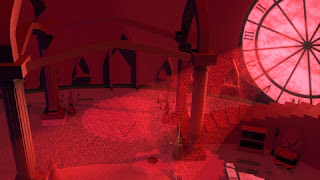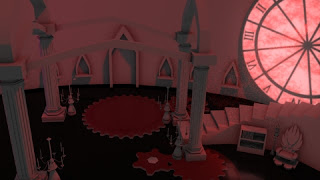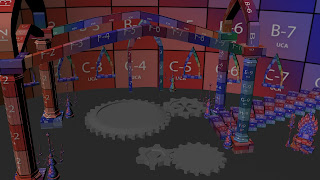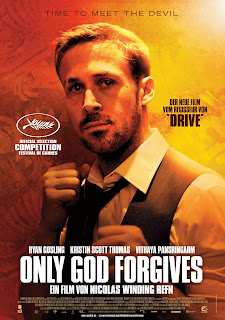 |
| Figure 1: Movie Poster [Still Image] |
Only God Forgives (2013) is a French – Danish co production, written and directed by Nicholas Winding Refn. It is a film that revolves around an American man, Julian, who owns a Muay Thai Club as a cover to his ultimate business trade; drugs. The story begins with his older brother, Billy, who brutally rapes and murders an underage prostitute. This triggered an investigation by Bangkok’s cop, Chang, who was also known as the Angel of Vengeance. He roams around the city with a samurai strapped to him, and carried out what seems to him as acts of justice, in his attempt to cleanse the city from perverts and criminals, in general.
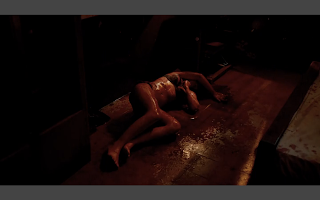 |
| Figure 2: Dead Woman covered in Blood [Still Image] |
An example of this would be in the opening scene where a dead female body covered in blood, lying on the floor of a dodgy hotel room as seen in Figure 2. As Lambie states in his review, “Drenched in blood, shadow and gaudy light, it’s a nightmarish film that refuses to play nicely from the opening scene to the last.” (Lambie, 2013)
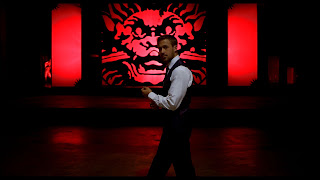 |
| Figure 3: Julian's Fight Scene [Still Image] |
The uses of the colours in this film were mostly primary colours, Red was evident in most scenes, and the darkness present throughout the film, projects some sort of suffocation that Julian feels. As Lambie points out “The use of intense colour and shadow gives the movie an oppressive, claustrophobic atmosphere” (Lambie, 2013)
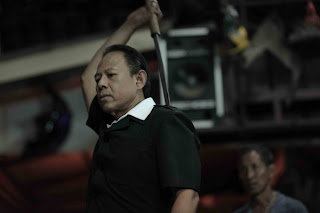 |
| Figure 4: Chang Drawing His Samurai [Still Image] |
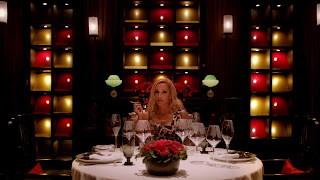 |
| Figure 5: Crystal In The Restaurant [Still Image] |
The camera are placed either at strategic angles or front on to create a balance shot. An example of a strategic angle would be when the camera is placed at a low angle, showing Chang’s emotionless expression as he draws a samurai from his back. An emotion that can be concluded from this would be superiority. The balanced shots, which, can be seen in the entire film, are similar to those in Kubrik’s film. The fronts on angles are as effective as those camera angles that have been strategically placed, as it was able to capture the emotions of a scene accurately. Woodward emphasized this point when he states “Whether gliding ominously down long, lavishly decorated corridors or fixed between doorframes looking into perfectly symmetrical rooms, DoP Larry Smith’s voyeuristic lens gives the film a hypnotic, haunted feel.” (Woodward, 2013)
In addition to the captivating, intense visuals, the sound played an important role as the film has very few dialogues. An example would be when the man that was hired by Julian’s mother, Crystal, to kill Chang was caught, he begged for mercy but it was muted and we could only see his pain and fear before Chang eventually sliced his body off, killing him instantly. In this scene, the sound was not audible and what can be interpreted from this is that no one will hear your cries and provide you any mercy for the crime you’ve committed and that you are alone to face the consequences. Bradshaw summarises the effective use of sound in the film when he states “Refn's movie is entirely gripping, put together with lethal, formal brilliance, with bizarre setpieces of sentimentality and nauseous black comedy. It has its own miasma of anxiety and evil, taking place in a universe of fear, a place of deep-sea unreality in which you need to breathe through special gills – and through which the action swims at about 90% of normal speed through to its chilling conclusion.” (Bradshaw, 2013)
Mottram concludes this movie accurately when he states, “It looks and sounds magnificent, perfectly conjuring the feel of backstreet Bangkok.” (Mottram, 2013)
List of Illustrations:
Figure 1 Only God Forgives (2013) [Poster] at http://www.impawards.com/2013/posters/only_god_forgives_ver7_xlg.jpg (Accessed on 11 December 2013)
Figure 2 Dead Woman Covered In Blood (2013) [Still Image] at http://cinema.theiapolis.com/movie-2TWY/only-god-forgives/news/only-god-forgives-1001929.html (Accessed on 11 December 2013)
Figure 3 Julian’s Fight Scene (2013) [Still Image] at http://bbdigitalproductions.com/wp-content/uploads/2013/07/ogre700.jpg (Accessed on 11 December 2013)
Figure 4 Chang Drawing His Samurai (2013) [Still Image] at http://www.bleedingcool.com/wp-content/uploads/2013/03/only-god-forgives-vithaya-pansringarm-600x400.jpg (Accessed on11 December 2013)
Figure 5 Crystal In The Restaurant (2013) [Still Image] at http://media-1.melty.fr/media_aggregate-1455442-stream/only-god-forgives-trois-extraits-violents.jpg (Accessed on 11 December 2013)
List of Bibliography:
Bradshaw, Peter
2013
Only God Forgives Review
http://www.theguardian.com/film/2013/aug/01/only-god-forgives-review
(Accessed on 11 December 2013)
Lambie , Ryan
2013
Only God Forgives Review
http://www.denofgeek.com/movies/only-god-forgives/26599/only-god-forgives-review
(Accessed on 11 December 2013)
Mottram , James
2013
Only God Forgives Review
http://www.totalfilm.com/reviews/cinema/only-god-forgives
(Accessed on 11 December 2013)
Woodward , Adam
2013
Only God Forgives Review
http://www.littlewhitelies.co.uk/theatrical-reviews/only-god-forgives-24418
(Accessed on 11 December 2013)































